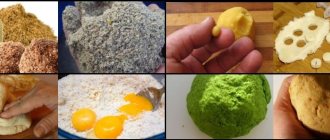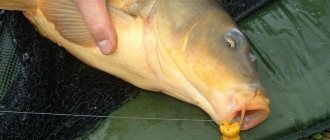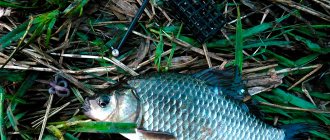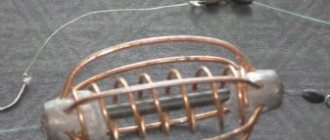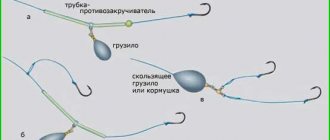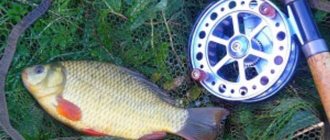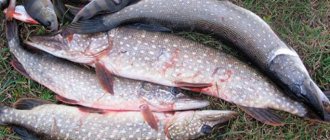Dough for crucian carp can be safely called a universal bait that can guarantee a catch under any fishing conditions. And this statement applies not only to the warm period of the year. After all, experienced fishermen who know the habits of crucian carp well successfully catch this fish using bait mixed with flour even in winter, from under the ice. Despite the capriciousness of the fish, plant bait of this type can always be adjusted to its behavior and make the crucian carp bite. But to do this, you need to master the technologies for preparing dough with different contents of ingredients and be able to prepare a mixture of the consistency required for fishing requirements.
In the article, we will look at the most popular recipes for preparing bait from flour materials, and also understand the types of bait, methods for reliably attaching bait to a hook, as well as options for storing it.
Advantages and disadvantages of catching crucian carp using dough
Let's consider a number of significant advantages that the use of the test for catching crucian carp provides. After all, the angler must clearly understand the benefits of using this bait in comparison with other possible bait options. We have already mentioned the versatility of using bait, but I would also like to note the simplicity of its preparation.
The process of preparing the mixture does not require complex recipes and uses common culinary ingredients that are not very expensive. During preparation, without much difficulty, the bait can be equipped with a promising attractant at a given time and painted in a color attractive to fish. The bait applied to the fishing zone can quickly collect crucian carp, attracting them by the formation of cloudy spots when the plastic flour mass dissolves. In addition, the size of the bait can be easily adjusted and the size of the expected trophy, cutting off small crucian carp and the same small things of other types of fish by mounting a large dumpling on the hook.
The disadvantages include the difficulty of securely attaching the bait to the hook, which requires the use of certain methods that require knowledge and additional accessories, as well as some nuances that arise when storing bait while fishing.
Spreading the dough
How to properly place the dough so that it stays on the hook better and does not arouse suspicion in the approaching crucian carp?
When catching carp with dough , as practice shows, it is best to use hooks with a short shank . It is also better to take a small hook number - but, of course, depending on the specimens being caught.
Some fishermen firmly convinced that the tip of the hook must be covered with dough , and it is strictly forbidden to leave it open.
In reality, this is not so important, since at the moment of swallowing this bait, the crucian carp does not notice such small details.
Sometimes the dough is used with such a liquid consistency that an ordinary syringe is used to attach this attachment to the hook.
In this case, the dough is literally wound around the hook. Naturally, for this to happen it must be sufficiently viscous.
If the dough is prepared correctly , it will stick well to the hook not only when fishing with hooks from the bottom, but also when fishing near the bottom.
However, if the bites of crucian carp are not frequent enough - as, for example, happens when catching large specimens , it is recommended to prepare a dough a denser consistency - so that you can roll the pellets out of it with your fingers and then put them on the hook.
Sometimes when catching crucian carp a so-called “sandwich” , when dough is placed one hook in combination with some kind of animal bait .
The dough rightfully gained popularity as an effective bait for catching crucian carp , and the ease of preparation and low cost of ingredients makes it accessible to even novice amateur fishermen .
Types and procedure for preparing dough for crucian carp
Dough for crucian carp is divided into two types, differing in their consistency and plasticity. Fishermen prepare a thick product, which is distinguished by the addition of a large amount of flour and a small volume of water. The bait prepared according to this principle is brought to a plastic state, similar in its properties to plasticine. These types of dough do not stick to your hands; it is enough to simply form them into a ball of the required size, which will be securely held on the hook. The final mass is elastic, elastic when stretched and is not subject to spontaneous leakage under the influence of water. You can take thick bait for fishing even in a plastic bag without worrying about its rapid deterioration.
The second type of dough suitable for fishing is the sticky consistency. The composition of such a product is characterized by an increased proportion of water relative to flour. As a result of mixing, the mass has a glue-like, medium-thick appearance, capable of spontaneous flow at low speed. The product is placed on the hook using a stick or syringe, and stored in a large container under a tight lid that prevents the mash from drying out. To securely attach adhesive types of attachments to the hook, peculiar devices are used that slow down the flow of the mass and its spontaneous discharge.
Despite the physical properties of the mixtures, various kinds of attractants and dyes are added to them, which makes the bait attractive and contributes to better attraction of fish to fishing areas.
Popular recipes
We will devote this chapter to recipes that allow you to most simply, but at the same time effectively prepare dough for crucian carp for various fishing conditions. The technologies for producing plastic flour masses that we bring to the attention of the reader are very popular among crucian carp fishing enthusiasts, and have also been tested by multi-season practice of successful fishing. Common ingredients and the ability to independently prepare bait both at home and right on the shore of a reservoir provide all the prerequisites for learning the secrets of technologies that contribute to high results in crucian carp fishing.
With semolina and garlic
The formulation of the plastic product consists of the following ingredients:
- Wheat flour - 1 part.
- Semolina – 1/5 part.
- Unrefined sunflower oil - 10–15 grams per portion of flour.
- Water is added as required for fishing conditions, depending on the plasticity of the mass.
- Crushed garlic - 3 small cloves per part of the flour.
Wheat flour is mixed with semolina and filled with a small portion of water. The mass is kneaded with your hands until a mixture similar to plasticine comes out. The dough is allowed to stand for 20 minutes, after which it is rolled in sunflower oil, kneading the product. The garlic cloves are crushed using a garlic press, and when preparing a large amount of bait, the garlic can be passed through a meat grinder and pressed into the resulting dough, after which the product is completely ready for use.
Mixed with milk
The technology presented below is more complex and will require more time and operations to implement. The fisherman stocks up with the following products:
- Wheat flour – 1 part.
- Milk – 1/10 part.
- Boiled chicken egg – 1 piece.
- Boiled potatoes are small tubers.
Add the boiled and subsequently cooled milk to the flour, obtaining a plastic but thick mass. Fry the resulting mixture in a frying pan over low heat until a dried and still elastic product emerges. Add the yolk of a boiled chicken egg to the mixture, intensively squeezing and mixing the cooled mixture with your hands. The last step is to add crushed boiled potatoes to the mixture. The output is an elastic elastic product.
With added sugar and vanillin
This type of recipe is considered the easiest way to prepare bait right on the shore of a reservoir. To implement it, stock up:
- Wheat flour – 1 part.
- Water – about 1/50 part.
- Granulated sugar – 5–10 grams.
- Vanillin - a pinch or 1-2 grams.
- Unrefined sunflower oil 10 grams.
We begin the work by mixing and dissolving sugar and vanillin in slightly warmed water. Pour the resulting syrup into wheat flour and knead the dough until the desired consistency of the product is obtained. After letting the mixture sit for half an hour, mix it with refined sunflower oil, obtaining a fragrant and non-sticky dough in its structure.
Boiled from wheat and rye flour
Fishing dough for crucian carp with an eye for making boilies can be produced using the technology presented below. The recipe requires:
- Wheat flour – 1 part.
- Rye flour – 1 part.
- Chicken egg – 1 piece.
- Honey, artificial honey – 10 grams.
- Water – 1/25 part.
- Sunflower oil -15 grams.
Initially, mix two types of flour with the addition of water until a plastic product is obtained. Add the yolk of a boiled chicken egg to the mixture, which has been brought to condition, thoroughly mixing with the dough mixture. After mixing, add honey to the dough, kneading the mixture until a homogeneous and viscous composition is obtained. Having received the plasticine, we make balls from it of the required size for fishing and throw them into boiling water. We determine the boilie’s readiness by the product’s emergence. Lubricate the strained and dried balls with sunflower oil and use them.
Semolina with breadcrumbs based on canned corn juice
This is a rather interesting and effective recipe, the aroma of which collects crucian carp from long distances to the fished point. To implement the idea you will need:
- Finely ground semolina – 1 part.
- Can of canned sweet corn - 1 piece.
- Finely ground breadcrumbs – 1 part.
Mix the breadcrumbs and semolina until the mixture is uniform in color, which can be easily done using a regular household mixer. Having opened a jar of corn, pour the juice into the mixture obtained from crackers and cereals, thus replacing water with it. In the process of pouring juice, we constantly knead the composition, ultimately obtaining an elastic and fragrant product. By adding juice, we adjust the consistency of the dough, making it thick or sticky.
With pea puree
It is common to prepare crucian carp bait based on pea puree. We will dwell on one of the simplest options for preparing the dough in more detail, offering the fisherman its recipe. The recipe includes:
- Semolina or wheat flour – 1 part.
- Peas – 1/2 part.
- Water - the amount required as the elastic composition is obtained.
- Attractant.
The first operation is the preparation of pea puree, which is achieved by boiling the grain until it is completely crumbly, after which the peas are thoroughly mixed and kneaded. After bringing the boiled grain to a puree state, it is added to flour or semolina and kneaded into the dough with the addition of water, adjusting the plasticity resulting from mixing. Having reached the mixture consistency required for fishing conditions, all that remains is to add a promising attractant, which, in addition to natural products, can be used in the form of essences and concentrates.
On egg yolks
Vegetable bait compositions based on chicken eggs also deserve the attention of lovers of crucian carp hunting. In addition to a specific smell that has a positive effect on the bite, these types of dough also have attractive natural colors, depending on the intensity of the additive. A primitive but highly effective recipe with the addition of yolk will require four tablespoons of wheat flour and one chicken egg, from which only the separated yolk will be used. The yolk is added to the flour, intensively mixing the components until a homogeneous mass is obtained, resulting in a tight, elastic product that is immediately ready for use. Sometimes, to create more distinct spots in the water, sunflower oil is added to the already prepared mix.
On egg whites
As an addition to the above presented composition, you can include a recipe for preparing bait using chicken egg whites. Using the same cooking technology, the egg yolk is replaced with white without changing the volume of flour itself. The difference between the recipes is the addition of raw sunflower seeds ground in a coffee grinder to the protein dough. The volume of the prepared mixture will require about 50 grams of seeds. The finished product is stored in a hermetically sealed container and its use should not exceed 10–12 hours. After this time, the dough deteriorates and ceases to attract fish.
Recipe with flour and potatoes
The dough for crucian carp can be mixed with boiled potatoes, using the following recipe and getting a bait that sits firmly on the hook. Required components:
- Wheat flour in a volume of 100 grams.
- Two medium-sized boiled potatoes.
- Two large cloves of garlic.
- Egg yolk extracted from a boiled chicken egg.
- Sunflower oil in a volume of 50 grams.
We pass all the above ingredients through a meat grinder twice, bringing the composition to a homogeneous material that is soft and elastic to the touch. After mixing the components of the bait, the plasticity of the substance is achieved by adding sunflower oil, stirring and kneading the mixture. The result is an elastic, thick, aromatic and attractive dough that is bright yellow in color.
Hard to beat thick dough
Every angler knows that fishing with dough has a weak point in terms of the reliability of attaching the bait to the hook. To solve this problem, astute fishermen have found one solution to the problem by adding ordinary medical cotton wool to various bait formulations. To ensure that the bait does not lose its attractiveness and at the same time obtains a certain rigidity for a high-quality hook attachment, 1/5 of the cotton wool is added to one part of the finished mass. When mixed, the cotton wool seems to reinforce a more plastic dough, making the mass of fibers denser, but does not greatly reduce its elastic properties. The bait obtained using this method is more difficult for the fish to knock off the hook, and it is easier for the fisherman to cast it and control it while retrieving it without fear of its spontaneous removal.
Honey as a supplement
I would like to dwell in more detail on one natural and quite effective attractant, which is worth paying attention to when preparing bait for crucian carp, and not neglecting the possibilities of its use in bait and fish-attracting mixtures. We'll talk about honey. Since crucian carp have a known sweet tooth, the inclusion of this sweet product in the bait can significantly increase the bite, and therefore increase the catch. Honey is added to the dough for crucian carp fishing at a rate not exceeding two tablespoons of the product per one large glass of flour. This ratio allows you to achieve a balance of ingredients and not oversaturate the mix, thereby alerting the fish with an excess of attractant.
Important! It is practical to dilute the honey with warm water to a syrup before mixing.
In this form, it will saturate the bait with smell much faster, and its distribution in the mixture will be uniform throughout the entire volume of the finished product.
How to make dough for fishing?
Secrets:
- To tint the dough and make colored bait, use only regular, light flour for cooking, since dark flour will not give any result, but will only spoil the color.
- When you go fishing for dough, always take some flour and sugar with you so that you can adjust the consistency of the bait and its sweetness on the spot.
- When fishing in cold water, add milk to the composition - you can mix it half and half with water when adding it to the flour.
- If fish are caught in warm water, add more grains and flour.
- When adding any flavoring to the dough, try to achieve such a concentration that it is felt well and does not “hit your nose” too much.
- To ensure that the dough holds tightly, special hooks are often used that have a spring on the fore-end.
Semolina dough recipe: hot cooking
- Semolina is poured into a pan with water in a ratio of 1:2. Stirring occasionally, cook for five to ten minutes after the water boils. Then add more dry semolina, a little honey, sunflower oil to the cooled porridge and mix well. Divide into balls of the required size and store them in the refrigerator.
- Pour boiling water over dry semolina, cover with a lid and allow to cool. Then add the selected spices, egg white and mix the resulting mass thoroughly.
- Just like in the second case, the semolina is poured with boiling water, but allowed to brew for literally ten minutes. Start making the dough while it has not completely cooled down. Add two teaspoons of sunflower oil and knead the dough until it stops sticking to your hands.
Semolina dough recipe: cold cooking
Raw semolina baits are called “chatterboxes” among fishermen. They are prepared for one time and, as a rule, just before going fishing or even on a pond.
Large-sized semolina is best suited for making “chatterboxes”.
Pour the semolina into any convenient container, stirring constantly, and gradually fill it with cold water. It is not recommended to use chlorinated tap water for chatterboxes; it is better to take rainwater or water from a reservoir.
Add cold water to the semolina; warm water will quickly wash off the dough in the water.
Wet the semolina completely with water so that there are no dry lumps left. Then drain off the excess water, leave a couple of millimeters on top of the cereal and let it sit for about half an hour.
When the semolina swells, mix it thoroughly until smooth. The correct consistency will be a moderately thick and viscous mass that stretches behind the stick and sticks well to the hook.
For convenience, such a “talker” can be placed in a large syringe and screwed onto a hook, gradually squeezing the prepared mixture out of it.
The second method of preparing semolina is used right next to a pond:
- A large piece of gauze must be folded several times, pour semolina into it and tie it in a knot.
- Rinse in water to remove small particles.
- The resulting dense mass is placed on a hook.
- In both the first and second cases, you can add any flavor to the bait.
Keep in mind that too soft semolina bait will quickly be washed away by water and will have to be re-attached for the next cast. Soft bait is suitable if you only fish with a fishing rod.
Pea fishing dough recipe
Pea dough is used to catch crucian carp, as well as most freshwater peaceful fish.
The peas are soaked in water for a day, then boiled until tender. The pan with pea porridge should be wrapped in a warm blanket and left to cool. Cook oatmeal.
When the peas have cooled, grind them with oatmeal, add a little flour and mix until smooth.
Fry the pea-oat pancakes in sunflower oil, cut them into pieces of the desired size - and the pea dough bait is ready.
This bait can also be flavored with vanilla, honey or fruit scents.
Roach, bream and crucian carp bite well on pea pancakes.
As in the first case, the peas are soaked in cold water, but not for a day, but only for a few hours. Then it must be washed and cooked for one and a half or two hours over low heat.
As a result, the peas should be boiled to a puree. Without removing from the heat, add semolina or flour to the peas and cook, stirring constantly, until the mass thickens.
When the resulting pea porridge has cooled, add flavoring, an egg and a few tablespoons of sunflower oil.
Dough for winter fishing for crucian carp
It’s easy to make dough for crucian carp during the ice fishing season. Fish respond well to this bait during the thaw period at the end of winter and early spring in those reservoirs where crucian carp are active throughout the year. And this behavior of crucian carp is directly related to the high oxygen content in the water. The recipes themselves for winter types of mash are practically no different in the composition of ingredients from the options for open water fishing. Attention is paid only to the addition of attractants, which are added in minimal quantities, or even completely excluded from the recipe, making a bland product, tinted with dyes in rich red tones.
Features of storing and using dough when fishing for crucian carp
The finished flour product is quite sensitive to loss of moisture and rapid souring when interacting with oxygen, therefore, regardless of the type of bait, it is stored in an airtight container. It is worth noting that the period of use of the mass depends on the ingredients used in the mix, since, for example, eggs and honey have different periods of time, allowing the product to remain unspoiled. Thick mash for fishing is stored in a tightly screwed glass or metal jar. Sticky consistencies are stored in disposable medical syringes, baby nipples and tubes adapted for the mixture in the image of toothpaste containers.
Important! The shelf life of flour attachments at temperatures similar to room temperature and above does not exceed one day. Over a longer period of time, the mash sours and becomes unsuitable for fishing.
If long-term storage of the product is expected, it is frozen. When frozen, the mixture can retain its properties for up to one month. For fishing, the required piece is cut off from the total volume, defrosting it at room temperature, then drying or moistening it to bring it to the required condition for fishing conditions. The product itself can be stored in the freezer in a plastic bag .
How to store while fishing
If you put the dough in your pocket or next to you on the grass, in a plastic box, or wrap it in a rag, it will quickly deteriorate: it will acquire an unpleasant odor and become crusty. In order for the dough to be preserved and not lose its original qualities, it is necessary to wrap it in cotton cloth. Then put this package in a plastic bag, which must be tightly closed so that moisture does not evaporate.
Important! If not all the dough was used up while fishing, you can save it for a long time by freezing it in the freezer of the refrigerator.
When fishing, you shouldn’t take out all the dough; just pinch off a small piece, which is enough for 2-3 casts, and hide the rest again. Then the bait will remain fresh and aromatic all the time. In hot weather, the dough packaged in this way can be hidden in the grass, buried or placed in water.
Hooking methods
There are several ways to attach the dough for catching crucian carp to a hook, depending on the density of the bait. Thick dough is rolled into balls or dumplings of a certain size and put on a hook, slightly squeezing the mixture. The adhesive mixture is applied to the hook using a syringe, wrapping the forearm and the tip in a spiral, thus winding the required volume. Smooth sticks are also used for bait, forming a compact bait.
A convenient method of fastening is using a spring put on the shank of the hook, in the winding of which the mixture is held much longer than when mounting the bait directly on the hook. The technique of securing the dough with a spring allows you to make reliable long casts. The spring itself can be taken by disassembling an old lighter or fountain pen and cutting off a piece of length suitable for the size of the fore-end.
